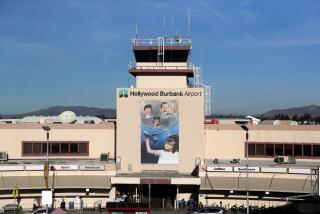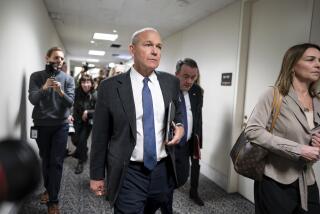Runway Is Clear for 767s to Fly at Burbank
- Share via
United Airlines cleared its last hurdle Monday to begin flying between Burbank Airport and Chicago with jetliners larger than others carrying passengers from the airfield. For safety reasons, however, the planes will not be allowed to park at the airport’s terminal.
To comply with a Federal Aviation Administration order, United must park the wide-bodied Boeing 767s in another area of the airport and shuttle passengers the equivalent of about four blocks to the terminal.
United’s plan in effect won final approval when members of the Burbank-Glendale-Pasadena Airport Authority acknowledged at a special meeting Monday that the airline and its planes meet engine noise and safety standards. The FAA attached six conditions to the safety approval, issued last week, including the parking restriction.
Letter Acknowledged
The commissioners did not vote at the meeting Monday but merely acknowledged receipt of a letter from the FAA approving the Boeing 767 from a safety standpoint. The commissioners agreed last month that the plane met noise standards.
The airport commissioners have long held that federal court rulings require them to accept as tenants any airline meeting the standards.
United announced plans in January for two round-trip flights a day between Burbank and Chicago beginning May 1, but the plan’s future has been shadowed by a cluster of related controversies.
Anti-noise groups, who object to an increase in the number of flights, raised questions about the size of the 767.
The largest plane now in passenger service at the airport, the DC-9-80, carries 140 to 150 passengers and has a wingspan of 108 feet. The Boeing 767 carries 197 passengers and has a wingspan of 156 feet.
The airport commissioners, responding to objections, asked the FAA for a safety opinion. With the safety question opened, the FAA took the occasion to step up pressure on the airport authority to replace the airport’s 56-year-old terminal, which is closer to the runway than allowed under modern safety regulations.
The FAA banned jetliner takeoffs toward the east and decreed that the airport must move the passenger apron. Both measures are aimed at putting more distance between the passenger boarding area and the runway.
Additional room for the planes could be taken from auto parking lots, the FAA suggested. The authority balked and said it would lose millions of dollars a year in parking revenues and further annoy passengers already aggravated by a parking shortage.
But the authority agreed under protest earlier this month to abolish 500 auto-parking spaces to make room for a boarding area, asking for federal financial aid in return.
To allay fears about the size of the 767, United staged a demonstration flight at Burbank for FAA inspectors April 4.
More to Read
Sign up for Essential California
The most important California stories and recommendations in your inbox every morning.
You may occasionally receive promotional content from the Los Angeles Times.













